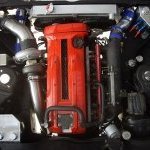Major Flat Spot
Announcements
-
Similar Content
-
Latest Posts
-
Got the gearbox in and the front drive shafts.
-
Hi There I went through a rabbit hole of reading about Xenon headlights and the ADR regulations for having them installed. As people have been defected by running factory xenon I was researching in ways to make them compliant. Everyone always say needs to be self leveling and have washer installed, which I don't necessarily agree with. For this argument I'm using R34 as reference as I'm more aware on the construction of the headlight compared to the R33 Xenon, which may still be the exact same case. For the self leveling clause taken from ADR 13 - Installation of Lighting and Light Signalling Devices on other than L-Group Vehicles As you can see the bold text "these manually adjustable devices from driver seats" are fine to use. As Series 1 Xenon model headlights do have a 4 level adjuster on the right near the ignition (however not series 2) then these model are consider compliant in that argument. For the Self Cleaning aspect of this argument clause taken from ADR 13 - Installation of Lighting and Light Signalling Devices on other than L-Group Vehicles Now i can understand the argument that Xenon will need a washer as they are over 2000 lumens, but I clicked on the 12 at the end of that sentence and it takes me to the end notes which states R34 for headlight lenses are plastic, not sure if PL is mark as I don't currently have my skyline to confirm that marking is there. But could you not technically get a lenses with the PL marking on it and then get away with the argument that you need a washer. I went through a quick read of the adr and might have missed something else that may cause them to be non-complaint. But wouldn't these technically be complaint headlights Would love to hear other people input on this and shed some light Edit In regard to the the washer portion I might be mistaken ADR 45 (which I believe is Regulation NO.45) states 12 cd (candela) I dont understand that portion in regarding to calculating the candela if anyone can shed some light. Otherwise I guess throw in a washer for the headlight and you definitely comply.
-
Took it to all Japan day, flogged the hell out of it and took it all, am a very very happy man don’t know how that ended up in Greg’s thread before
-
I'd say closer to OG GTX3582R, just smaller trim - so 59mm inducer/82mm exducer as opposed to 62/82 for the first gen GTX3582R. Yeah EFRs were boss, the EFR8474 is still an absolute beast and it perplexes me that people still go to things like Turbosmart/Garrett etc when the results people are getting with those are pretty unremarkable compared to what you could get with a turbo available well before those options came out. DriftSquid (I think) "upgraded" from an EFR9174 to a Turbosmart turbo and promised a comparison video - and kinda shuffled awkwardly and did a bit of diversion from the fact that they didn't get any improvement going to the currently massively hyped brand of turbo from a turbo that was a bit of a frankenstein that had been well superceded in it's own range before the Turbosmart unit he put on there even came out. I suspect the EFR would outperform most Xonas for what a lot of less-insane RB owners would go for, in the 400-600kw range but the Xonas are looking hard to beat up to maybe in the mid 700kw range at this stage- basically where EFRs don't really reach, and before the Precision turbos take over. What the Xonas do well in the "EFR range" is be easier to package etc, and work very well if a divided housing doesn't suit your application.
-









Recommended Posts
Create an account or sign in to comment
You need to be a member in order to leave a comment
Create an account
Sign up for a new account in our community. It's easy!
Register a new accountSign in
Already have an account? Sign in here.
Sign In Now